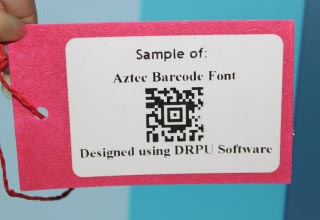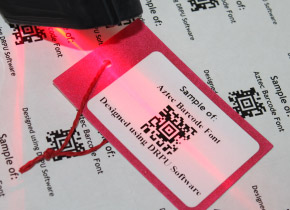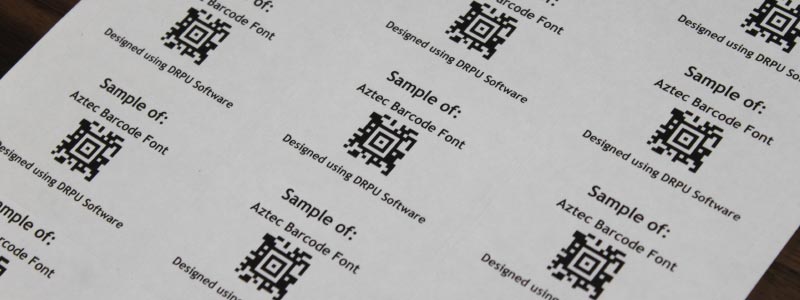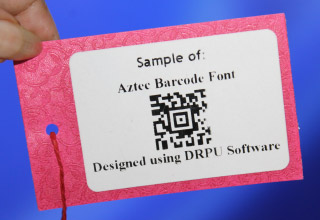👤 Digital Deeper
📅
🕔 7 Minutes
Aztec barcode is a two-dimensional matrix barcode that is capable of storing large amounts of data in a small space. It is named after the Aztec civilization, which was known for their intricate use of patterns in their artwork. The Aztec barcode was developed by Andrew Longacre, Jr. of Welch Allyn, Inc. in 1995, and it is now used in a wide range of applications, including transportation, retail, and healthcare.
Aztec Barcode System
➤ The Aztec barcode consists of a square or rectangular grid of black and white cells, with a bullseye pattern in the center. The bullseye is used to determine the orientation of the barcode, and the cells around the bullseye contain data. Aztec barcodes can be read from any direction, making them highly versatile.

➤ Aztec barcodes can store up to 3,000 characters of data, which is much more than traditional one-dimensional barcodes. The data can be a mix of text, numbers, and even binary data such as images or audio. Aztec barcodes also have built-in error correction, which means that if some of the cells are damaged or obscured, the barcode can still be read accurately.
➤ The Aztec barcode is considered to be more secure than traditional barcodes, as it is more difficult to counterfeit or copy. This is because the barcode contains both data and error correction codes, making it more difficult to alter without being detected.
📝In summary, the Aztec barcode is a two-dimensional matrix barcode that is capable of storing large amounts of data in a small space. It is highly versatile, can be read from any direction, and has built-in error correction. It is used in a wide range of applications, including transportation, retail, and healthcare, and is considered to be more secure than traditional barcodes.
Scanning Of Aztec Barcode System

Aztec barcodes can be scanned using a variety of devices such as handheld scanners, mobile devices, and stationary scanners. The scanning process involves capturing an image of the barcode and decoding it using specialized software or hardware.
Stationary scanners, also known as fixed-mount scanners, are typically used in manufacturing and logistics applications. These scanners are installed in a fixed location and can scan Aztec barcodes on products or packages as they move past the scanner. Stationary scanners can use a variety of technologies such as lasers, cameras, or radio-frequency identification (RFID) to capture barcode data.
Handheld scanners are commonly used to scan Aztec barcodes. These scanners use a laser or a camera to capture an image of the barcode. The scanner then sends the image to a computer or a mobile device for decoding. Handheld scanners can be corded or cordless, with cordless scanners typically using Bluetooth technology to communicate with a computer or mobile device.
Mobile devices, such as smartphones and tablets, can also be used to scan Aztec barcodes. These devices use the built-in camera to capture an image of the barcode. The image is then processed by a barcode scanning app installed on the device. These apps use specialized algorithms to decode the barcode and extract the encoded information.
In addition to traditional scanning methods, there are also specialized devices such as kiosks and vending machines that can scan Aztec barcodes. These devices use a built-in scanner or camera to capture the barcode, which is then decoded to initiate a transaction or dispense a product.
📝Overall, the scanning process for Aztec barcodes is relatively simple and can be done using a wide range of devices. The key is to ensure that the device being used is compatible with the barcode type and can accurately capture and decode the barcode image.
Structure Of An Aztec Barcode
🟆 Aztec barcode is a two-dimensional matrix barcode, consisting of black and white squares arranged in a square grid. The symbol size of an Aztec barcode ranges from a minimum of 15 by 15 modules to a maximum of 151 by 151 modules. Each module can be either black or white, and the Aztec barcode can encode up to 3,588 characters.
🟆 The structure of an Aztec barcode is based on a central finder pattern, which consists of a solid square surrounded by a concentric set of alternating black and white squares. The finder pattern helps to locate the barcode and orient it correctly for scanning. The rest of the Aztec barcode is divided into a number of concentric rings, each consisting of alternating black and white squares. These rings contain the data to be encoded.

🟆 The innermost ring, known as the bullseye, is the smallest and contains the most significant bits of the data. The outer rings contain progressively less significant bits of the data. The number of rings and the number of modules in each ring depend on the symbol size of the barcode and the amount of data to be encoded.
🟆 The Aztec barcode also includes error correction codes to ensure that the data can be accurately decoded even if some of the modules are damaged or unreadable. The error correction codes are based on Reed-Solomon coding and can correct up to 25% of the modules in the barcode.
📝In addition to the data and error correction codes, the Aztec barcode also includes a number of control characters that indicate the start and end of the data, as well as any special formatting or encoding instructions. These control characters are encoded using a special algorithm to ensure that they can be distinguished from the data.
Limitations Of Using An Aztec Barcode
The Aztec barcode has several limitations that users should consider before implementing it. Here are some of the limitations:
-
Size
limitation:
While Aztec barcode is more compact than other 2D barcodes, it still requires a certain amount of space to print. The smallest printable Aztec code size is 15x15 modules, while the largest is 151x151 modules. The size limitation of the Aztec code means that it may not be suitable for applications where space is limited.
-
Limited error
correction:
Aztec barcode can only correct up to 25% of errors in the code. This means that if more than 25% of the code is damaged or obscured, the barcode may not be able to be read. This limitation makes Aztec barcode less suitable for applications that require high levels of error correction.
-
Requires
high-quality
printing:
The Aztec code requires high-quality printing for accurate reading. If the code is not printed correctly, it may not be readable by scanners.
-
Limited
adoption:
Although Aztec barcode is gaining popularity, it is not as widely adopted as some other 2D barcodes like QR code. This may limit its usefulness in some applications.
-
Limited encoding
capacity:
While Aztec code can encode a variety of data types, it has a limited encoding capacity compared to other 2D barcodes. This may be a limitation for applications that require encoding large amounts of data.
-
Reliance
specialized scanner:
Unlike 1D barcodes, Aztec code requires a specialized scanner to read. This means that businesses must invest in specialized hardware to use the Aztec code, which may be an added expense.
-
Limited
readability
angles:
Aztec barcode requires a direct line of sight for reading. It has limited readability angles, which means it cannot be read from all angles. This may be a limitation in applications where the barcode is difficult to position for scanning.
📝In summary, the Aztec barcode has several limitations that must be considered before implementation. The size limitation, limited error correction, high-quality printing requirement, limited adoption, limited encoding capacity, reliance on specialized hardware, and limited readability angles are all factors to consider.
Minimum And Maximum Size Of An Aztec Barcode
Aztec barcode is a two-dimensional matrix barcode that is used for storing large amounts of data in a small space. The size of an Aztec barcode can vary depending on the amount of data it needs to store, the printing resolution, and the scanning distance. The minimum and maximum size of an Aztec barcode are determined by the symbol size and the error correction level used.
The symbol size of an Aztec barcode refers to the number of modules (black and white squares) in the barcode. The minimum symbol size of an Aztec barcode is 15x15 modules, while the maximum symbol size is 151x151 modules. However, not all sizes are practical or commonly used. The most common symbol sizes used are between 19x19 modules and 67x67 modules.

The error correction level of an Aztec barcode determines the amount of redundancy built into the barcode to ensure accurate decoding even if part of the barcode is damaged or obscured. The higher the error correction level, the larger the barcode will be. The error correction level can be set to 5%, 10%, 20%, or 23%. The minimum size of an Aztec barcode with 5% error correction is 15x15 modules, while the maximum size with 23% error correction is 151x151 modules.
In general, the size of an Aztec barcode is smaller compared to other 2D barcodes such as Data Matrix or QR code, while still being able to store a large amount of data. This makes it suitable for applications where space is limited, such as on a printed product label or a mobile device screen.
📝 It is important to note that the size of an Aztec barcode is also affected by the printing resolution and the scanning distance. Higher printing resolution will result in a larger barcode, while scanning at a shorter distance will require a larger barcode size.